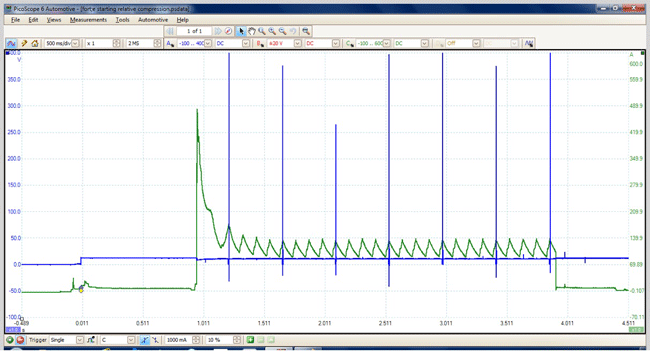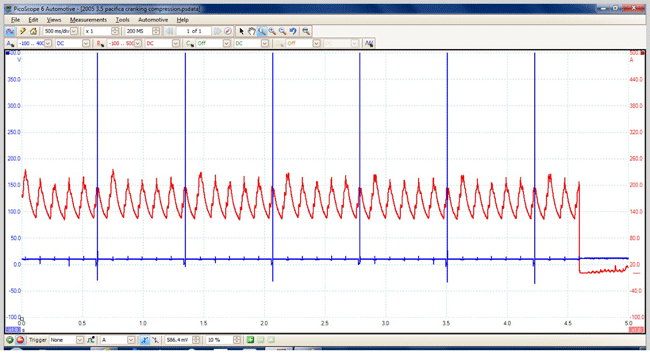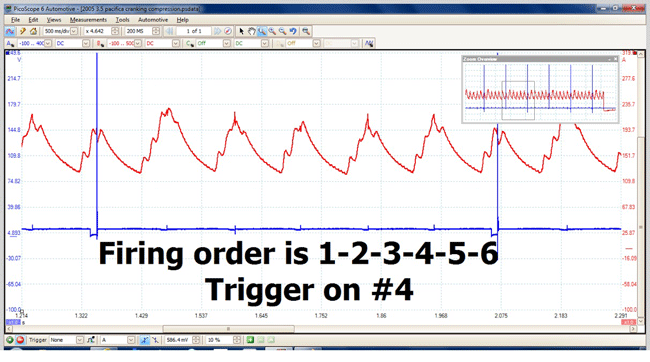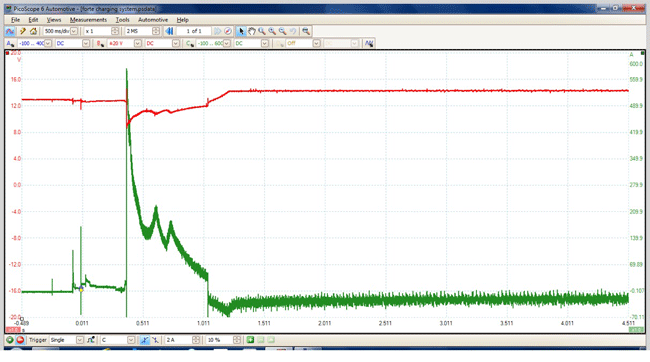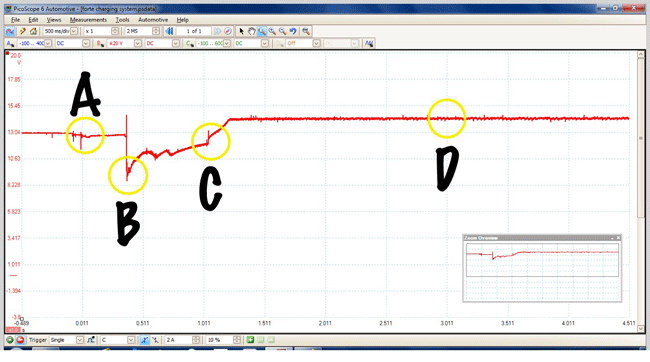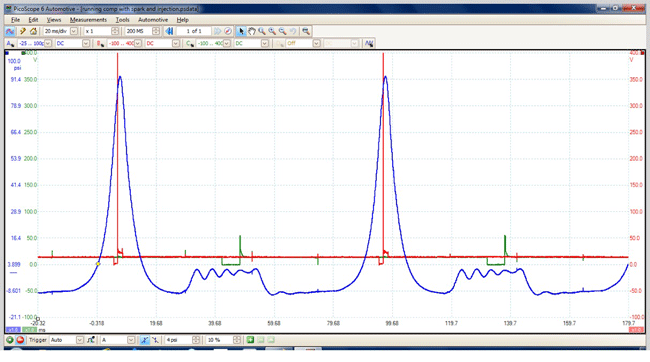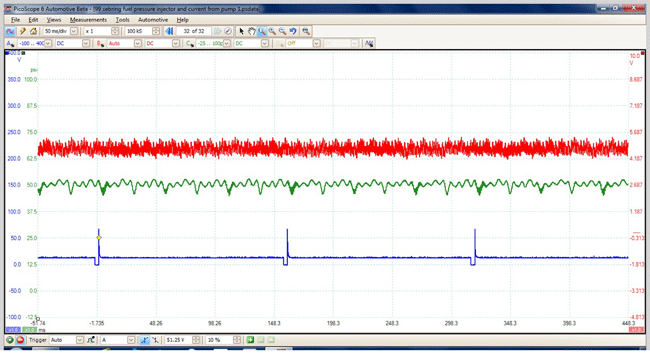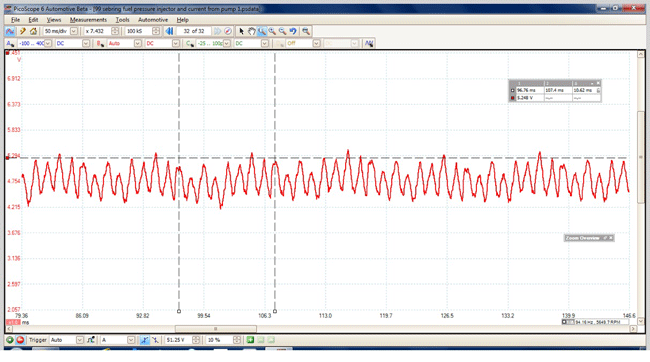 Typical A/C system[/caption]
The High-pressure Side
All automotive air conditioning systems are (nearly) closed loops with a high-pressure side and low-pressure side. We’ll start with the high-pressure side as it leads from the engine to the passenger compartment.
Compressor: The compressor is a pump driven by a belt attached to the engine’s crankshaft. When the refrigerant is drawn into the compressor, it is in a low-pressure gaseous form. Once the gas is inside the pump, the compressor lives up to its name. The belt drives the pump, which puts the gas under pressure and forces it out to the condenser. Compressors cannot compress liquids, only gasses. You’ll see as we go through the system that there are other parts whose job it is to capture any water that accidentally makes into the AC loop.
Condenser: The condenser is basically a radiator, and it serves the same purpose as the one in your car: to radiate heat out of the system. The refrigerant enters the condenser as a pressurized gas from the compressor. The process of pressurizing the gas and moving it to the condenser creates heat, but air flowing around the twisting tubes of the condenser cools the refrigerant down until it forms a liquid again. Imagine steam cooling down and condensing back into water, and you’ve got the idea. The liquid refrigerant is now a high-pressure liquid and nearly ready to cool the car.
Receiver-Dryer: But first, the refrigerant needs to be prepped for the evaporator. As it moves out of the condenser, the liquid goes through a little reservoir installed in the line. This receiver-dryer contains desiccants, small granules that attract water. You’ve seen packets of desiccants in shoeboxes, where they do the same thing: attract water from the air to keep new shoes fresh and ready for your feet. (They’re usually labeled “Do not eat.”) In the receiver-dryer, they remove any water that has entered the system. If the water is allowed to remain and possibly form ice crystals, it can damage the air conditioning system.
That’s enough high-pressure for anyone, so let’s move on to the low-pressure side of the system.
The Low-pressure Side
Thermal Expansion Valve (TXV): Here, the system changes from the high-pressure side to the low-pressure side. If you were to touch this part of the system, you’d feel it change from hot to cold.
The high-pressure liquid refrigerant flows from the receiver-dryer through the expansion valve, where it is allowed to expand. This expansion reduces the pressure on the refrigerant, so it can move into the evaporator. The valve senses pressure and regulates the flow of refrigerant, which allows the system to operate steadily, but the moving parts of the valve can wear out and sometimes require replacement.
Some vehicles have an orifice tube rather than an expansion valve, but it serves the same purpose in allowing the refrigerant to expand and the pressure to be lowered before the liquid enters the evaporator. The orifice tube allows refrigerant to flow at a constant rate and has no moving parts, but it can become clogged with debris over time. Systems with an orifice tube automatically turn the AC system on and off to regulate the flow of refrigerant to the evaporator.
Evaporator: This is where the magic happens. While all the other parts of the system are located in the engine compartment, this one is in the cabin, usually above the footwell on the passenger side. It also looks like a radiator, with its coil of tubes and fins, but its job is to absorb heat rather than dissipate it.
Refrigerant enters the evaporator coil as a cold, low-pressure liquid, ideally at 32 degrees Fahrenheit (0 degrees Celsius), which is why you don’t want any water in the system. The refrigerant doesn’t freeze at this temperature, but it does have a very low boiling point. The heat in the cabin of the car is enough to make the R-134a in the evaporator boil and become a gas again, just like water turning back to steam. In its gaseous form, the refrigerant can absorb a lot of heat.
The gas moves out of the evaporator — and out of the passenger compartment of the car, taking the heat with it. A fan blowing over the outside of the evaporator coil blows cool air into the passenger compartment. The refrigerant in gas form then enters the compressor, where it is pressurized and the whole process starts all over again.
If the system uses an orifice tube, there will be an accumulator between the evaporator and the compressor. An orifice tube sometimes lets too much refrigerant into the evaporator and it doesn’t all boil. Since the compressor cannot compress liquid, only gas, the accumulator traps any excess liquid before it can get into the compressor.
The evaporator also takes humidity out of the air in the car, which helps you feel cool. Water in the air condenses on the evaporator coil, along with dirt and pollen and anything else floating around in the cabin. When you stop the car and see water dripping underneath, it’s probably the water from the AC evaporator and nothing to worry about.
We’ve all heard about “recharging the A/C,” so we’ll take a quick look at that next.
Recharging a Car’s A/C
Most of us start seeing ads in the spring for car repair shops offering deals on recharging your car’s air conditioning in time for the coming summer. Which makes us ask, what is recharging the A/C? Is it required, like an oil change? Does my car’s air conditioning need to be recharged? Is this another scam that repair shops can pull on unsuspecting customers?
The answer to that last one is definitely no; recharging the A/C is not a scam. It simply means that fresh refrigerant is added to the system. If the refrigerant is a bit low, it can be topped off, the same as if you were a bit low on oil in the engine. If it’s really low, though, whatever refrigerant is still in the system needs to be drained out and replaced. This process of clearing out the system and adding new fluid is called recharging.
In either case, you’ve lost some refrigerant, which isn’t so great. Even though R-134a is better for the environment than Freon, the Environmental Protection Agency would rather not have any air conditioning refrigerant leaking into the soil and rivers. If you’re going to have the system drained and recharged, the EPA recommends having the technician take a look at the system to find the source of the leak and fix it. They don’t require the repair, but they’d really, really like you to have it done.
This article has talked a lot about R-134a as a replacement for big, bad Freon, but there are others that have been approved by the EPA, too. R-134a has the distinction of being the refrigerant most tested and recommended by manufacturers, but there are others with names like Free Zone, Freeze 12, and Kar Kool that the EPA will allow in automotive air conditioning systems.
Click Here to learn about the new refrigerant R1234yf
Typical A/C system[/caption]
The High-pressure Side
All automotive air conditioning systems are (nearly) closed loops with a high-pressure side and low-pressure side. We’ll start with the high-pressure side as it leads from the engine to the passenger compartment.
Compressor: The compressor is a pump driven by a belt attached to the engine’s crankshaft. When the refrigerant is drawn into the compressor, it is in a low-pressure gaseous form. Once the gas is inside the pump, the compressor lives up to its name. The belt drives the pump, which puts the gas under pressure and forces it out to the condenser. Compressors cannot compress liquids, only gasses. You’ll see as we go through the system that there are other parts whose job it is to capture any water that accidentally makes into the AC loop.
Condenser: The condenser is basically a radiator, and it serves the same purpose as the one in your car: to radiate heat out of the system. The refrigerant enters the condenser as a pressurized gas from the compressor. The process of pressurizing the gas and moving it to the condenser creates heat, but air flowing around the twisting tubes of the condenser cools the refrigerant down until it forms a liquid again. Imagine steam cooling down and condensing back into water, and you’ve got the idea. The liquid refrigerant is now a high-pressure liquid and nearly ready to cool the car.
Receiver-Dryer: But first, the refrigerant needs to be prepped for the evaporator. As it moves out of the condenser, the liquid goes through a little reservoir installed in the line. This receiver-dryer contains desiccants, small granules that attract water. You’ve seen packets of desiccants in shoeboxes, where they do the same thing: attract water from the air to keep new shoes fresh and ready for your feet. (They’re usually labeled “Do not eat.”) In the receiver-dryer, they remove any water that has entered the system. If the water is allowed to remain and possibly form ice crystals, it can damage the air conditioning system.
That’s enough high-pressure for anyone, so let’s move on to the low-pressure side of the system.
The Low-pressure Side
Thermal Expansion Valve (TXV): Here, the system changes from the high-pressure side to the low-pressure side. If you were to touch this part of the system, you’d feel it change from hot to cold.
The high-pressure liquid refrigerant flows from the receiver-dryer through the expansion valve, where it is allowed to expand. This expansion reduces the pressure on the refrigerant, so it can move into the evaporator. The valve senses pressure and regulates the flow of refrigerant, which allows the system to operate steadily, but the moving parts of the valve can wear out and sometimes require replacement.
Some vehicles have an orifice tube rather than an expansion valve, but it serves the same purpose in allowing the refrigerant to expand and the pressure to be lowered before the liquid enters the evaporator. The orifice tube allows refrigerant to flow at a constant rate and has no moving parts, but it can become clogged with debris over time. Systems with an orifice tube automatically turn the AC system on and off to regulate the flow of refrigerant to the evaporator.
Evaporator: This is where the magic happens. While all the other parts of the system are located in the engine compartment, this one is in the cabin, usually above the footwell on the passenger side. It also looks like a radiator, with its coil of tubes and fins, but its job is to absorb heat rather than dissipate it.
Refrigerant enters the evaporator coil as a cold, low-pressure liquid, ideally at 32 degrees Fahrenheit (0 degrees Celsius), which is why you don’t want any water in the system. The refrigerant doesn’t freeze at this temperature, but it does have a very low boiling point. The heat in the cabin of the car is enough to make the R-134a in the evaporator boil and become a gas again, just like water turning back to steam. In its gaseous form, the refrigerant can absorb a lot of heat.
The gas moves out of the evaporator — and out of the passenger compartment of the car, taking the heat with it. A fan blowing over the outside of the evaporator coil blows cool air into the passenger compartment. The refrigerant in gas form then enters the compressor, where it is pressurized and the whole process starts all over again.
If the system uses an orifice tube, there will be an accumulator between the evaporator and the compressor. An orifice tube sometimes lets too much refrigerant into the evaporator and it doesn’t all boil. Since the compressor cannot compress liquid, only gas, the accumulator traps any excess liquid before it can get into the compressor.
The evaporator also takes humidity out of the air in the car, which helps you feel cool. Water in the air condenses on the evaporator coil, along with dirt and pollen and anything else floating around in the cabin. When you stop the car and see water dripping underneath, it’s probably the water from the AC evaporator and nothing to worry about.
We’ve all heard about “recharging the A/C,” so we’ll take a quick look at that next.
Recharging a Car’s A/C
Most of us start seeing ads in the spring for car repair shops offering deals on recharging your car’s air conditioning in time for the coming summer. Which makes us ask, what is recharging the A/C? Is it required, like an oil change? Does my car’s air conditioning need to be recharged? Is this another scam that repair shops can pull on unsuspecting customers?
The answer to that last one is definitely no; recharging the A/C is not a scam. It simply means that fresh refrigerant is added to the system. If the refrigerant is a bit low, it can be topped off, the same as if you were a bit low on oil in the engine. If it’s really low, though, whatever refrigerant is still in the system needs to be drained out and replaced. This process of clearing out the system and adding new fluid is called recharging.
In either case, you’ve lost some refrigerant, which isn’t so great. Even though R-134a is better for the environment than Freon, the Environmental Protection Agency would rather not have any air conditioning refrigerant leaking into the soil and rivers. If you’re going to have the system drained and recharged, the EPA recommends having the technician take a look at the system to find the source of the leak and fix it. They don’t require the repair, but they’d really, really like you to have it done.
This article has talked a lot about R-134a as a replacement for big, bad Freon, but there are others that have been approved by the EPA, too. R-134a has the distinction of being the refrigerant most tested and recommended by manufacturers, but there are others with names like Free Zone, Freeze 12, and Kar Kool that the EPA will allow in automotive air conditioning systems.
Click Here to learn about the new refrigerant R1234yf
Cleaning the Condenser
Increasing AC performance by cleaning your condenser was a surprise to me. Eric the Car Guy turned me onto this. For those who don’t know He has Youtube channel and shows his viewers about the benefits of cleaning condenser coils. He says one of the biggest reasons that AC systems fail is due to increased head pressure in the compressor. Higher pressures equal more heat. The increased heat breaks down the lubricant. Once that happens, it’s not long before the compressor fails. One way to keep down compressor temperature is to lower high side pressures in the AC system. You can do this by increasing the condensers efficiency by cleaning it. Honestly, I was amazed at the result. This really works and doesn’t require that you open the AC system at all to do it. So if your AC isn’t working as good as it should, you might try this process to see if it helps.
Click Here to see the Eric the Car Guy Video]]>

 Typical A/C system[/caption]
The High-pressure Side
All automotive air conditioning systems are (nearly) closed loops with a high-pressure side and low-pressure side. We’ll start with the high-pressure side as it leads from the engine to the passenger compartment.
Compressor: The compressor is a pump driven by a belt attached to the engine’s crankshaft. When the refrigerant is drawn into the compressor, it is in a low-pressure gaseous form. Once the gas is inside the pump, the compressor lives up to its name. The belt drives the pump, which puts the gas under pressure and forces it out to the condenser. Compressors cannot compress liquids, only gasses. You’ll see as we go through the system that there are other parts whose job it is to capture any water that accidentally makes into the AC loop.
Condenser: The condenser is basically a radiator, and it serves the same purpose as the one in your car: to radiate heat out of the system. The refrigerant enters the condenser as a pressurized gas from the compressor. The process of pressurizing the gas and moving it to the condenser creates heat, but air flowing around the twisting tubes of the condenser cools the refrigerant down until it forms a liquid again. Imagine steam cooling down and condensing back into water, and you’ve got the idea. The liquid refrigerant is now a high-pressure liquid and nearly ready to cool the car.
Receiver-Dryer: But first, the refrigerant needs to be prepped for the evaporator. As it moves out of the condenser, the liquid goes through a little reservoir installed in the line. This receiver-dryer contains desiccants, small granules that attract water. You’ve seen packets of desiccants in shoeboxes, where they do the same thing: attract water from the air to keep new shoes fresh and ready for your feet. (They’re usually labeled “Do not eat.”) In the receiver-dryer, they remove any water that has entered the system. If the water is allowed to remain and possibly form ice crystals, it can damage the air conditioning system.
That’s enough high-pressure for anyone, so let’s move on to the low-pressure side of the system.
The Low-pressure Side
Thermal Expansion Valve (TXV): Here, the system changes from the high-pressure side to the low-pressure side. If you were to touch this part of the system, you’d feel it change from hot to cold.
The high-pressure liquid refrigerant flows from the receiver-dryer through the expansion valve, where it is allowed to expand. This expansion reduces the pressure on the refrigerant, so it can move into the evaporator. The valve senses pressure and regulates the flow of refrigerant, which allows the system to operate steadily, but the moving parts of the valve can wear out and sometimes require replacement.
Some vehicles have an orifice tube rather than an expansion valve, but it serves the same purpose in allowing the refrigerant to expand and the pressure to be lowered before the liquid enters the evaporator. The orifice tube allows refrigerant to flow at a constant rate and has no moving parts, but it can become clogged with debris over time. Systems with an orifice tube automatically turn the AC system on and off to regulate the flow of refrigerant to the evaporator.
Evaporator: This is where the magic happens. While all the other parts of the system are located in the engine compartment, this one is in the cabin, usually above the footwell on the passenger side. It also looks like a radiator, with its coil of tubes and fins, but its job is to absorb heat rather than dissipate it.
Refrigerant enters the evaporator coil as a cold, low-pressure liquid, ideally at 32 degrees Fahrenheit (0 degrees Celsius), which is why you don’t want any water in the system. The refrigerant doesn’t freeze at this temperature, but it does have a very low boiling point. The heat in the cabin of the car is enough to make the R-134a in the evaporator boil and become a gas again, just like water turning back to steam. In its gaseous form, the refrigerant can absorb a lot of heat.
The gas moves out of the evaporator — and out of the passenger compartment of the car, taking the heat with it. A fan blowing over the outside of the evaporator coil blows cool air into the passenger compartment. The refrigerant in gas form then enters the compressor, where it is pressurized and the whole process starts all over again.
If the system uses an orifice tube, there will be an accumulator between the evaporator and the compressor. An orifice tube sometimes lets too much refrigerant into the evaporator and it doesn’t all boil. Since the compressor cannot compress liquid, only gas, the accumulator traps any excess liquid before it can get into the compressor.
The evaporator also takes humidity out of the air in the car, which helps you feel cool. Water in the air condenses on the evaporator coil, along with dirt and pollen and anything else floating around in the cabin. When you stop the car and see water dripping underneath, it’s probably the water from the AC evaporator and nothing to worry about.
We’ve all heard about “recharging the A/C,” so we’ll take a quick look at that next.
Recharging a Car’s A/C
Most of us start seeing ads in the spring for car repair shops offering deals on recharging your car’s air conditioning in time for the coming summer. Which makes us ask, what is recharging the A/C? Is it required, like an oil change? Does my car’s air conditioning need to be recharged? Is this another scam that repair shops can pull on unsuspecting customers?
The answer to that last one is definitely no; recharging the A/C is not a scam. It simply means that fresh refrigerant is added to the system. If the refrigerant is a bit low, it can be topped off, the same as if you were a bit low on oil in the engine. If it’s really low, though, whatever refrigerant is still in the system needs to be drained out and replaced. This process of clearing out the system and adding new fluid is called recharging.
In either case, you’ve lost some refrigerant, which isn’t so great. Even though R-134a is better for the environment than Freon, the Environmental Protection Agency would rather not have any air conditioning refrigerant leaking into the soil and rivers. If you’re going to have the system drained and recharged, the EPA recommends having the technician take a look at the system to find the source of the leak and fix it. They don’t require the repair, but they’d really, really like you to have it done.
This article has talked a lot about R-134a as a replacement for big, bad Freon, but there are others that have been approved by the EPA, too. R-134a has the distinction of being the refrigerant most tested and recommended by manufacturers, but there are others with names like Free Zone, Freeze 12, and Kar Kool that the EPA will allow in automotive air conditioning systems.
Typical A/C system[/caption]
The High-pressure Side
All automotive air conditioning systems are (nearly) closed loops with a high-pressure side and low-pressure side. We’ll start with the high-pressure side as it leads from the engine to the passenger compartment.
Compressor: The compressor is a pump driven by a belt attached to the engine’s crankshaft. When the refrigerant is drawn into the compressor, it is in a low-pressure gaseous form. Once the gas is inside the pump, the compressor lives up to its name. The belt drives the pump, which puts the gas under pressure and forces it out to the condenser. Compressors cannot compress liquids, only gasses. You’ll see as we go through the system that there are other parts whose job it is to capture any water that accidentally makes into the AC loop.
Condenser: The condenser is basically a radiator, and it serves the same purpose as the one in your car: to radiate heat out of the system. The refrigerant enters the condenser as a pressurized gas from the compressor. The process of pressurizing the gas and moving it to the condenser creates heat, but air flowing around the twisting tubes of the condenser cools the refrigerant down until it forms a liquid again. Imagine steam cooling down and condensing back into water, and you’ve got the idea. The liquid refrigerant is now a high-pressure liquid and nearly ready to cool the car.
Receiver-Dryer: But first, the refrigerant needs to be prepped for the evaporator. As it moves out of the condenser, the liquid goes through a little reservoir installed in the line. This receiver-dryer contains desiccants, small granules that attract water. You’ve seen packets of desiccants in shoeboxes, where they do the same thing: attract water from the air to keep new shoes fresh and ready for your feet. (They’re usually labeled “Do not eat.”) In the receiver-dryer, they remove any water that has entered the system. If the water is allowed to remain and possibly form ice crystals, it can damage the air conditioning system.
That’s enough high-pressure for anyone, so let’s move on to the low-pressure side of the system.
The Low-pressure Side
Thermal Expansion Valve (TXV): Here, the system changes from the high-pressure side to the low-pressure side. If you were to touch this part of the system, you’d feel it change from hot to cold.
The high-pressure liquid refrigerant flows from the receiver-dryer through the expansion valve, where it is allowed to expand. This expansion reduces the pressure on the refrigerant, so it can move into the evaporator. The valve senses pressure and regulates the flow of refrigerant, which allows the system to operate steadily, but the moving parts of the valve can wear out and sometimes require replacement.
Some vehicles have an orifice tube rather than an expansion valve, but it serves the same purpose in allowing the refrigerant to expand and the pressure to be lowered before the liquid enters the evaporator. The orifice tube allows refrigerant to flow at a constant rate and has no moving parts, but it can become clogged with debris over time. Systems with an orifice tube automatically turn the AC system on and off to regulate the flow of refrigerant to the evaporator.
Evaporator: This is where the magic happens. While all the other parts of the system are located in the engine compartment, this one is in the cabin, usually above the footwell on the passenger side. It also looks like a radiator, with its coil of tubes and fins, but its job is to absorb heat rather than dissipate it.
Refrigerant enters the evaporator coil as a cold, low-pressure liquid, ideally at 32 degrees Fahrenheit (0 degrees Celsius), which is why you don’t want any water in the system. The refrigerant doesn’t freeze at this temperature, but it does have a very low boiling point. The heat in the cabin of the car is enough to make the R-134a in the evaporator boil and become a gas again, just like water turning back to steam. In its gaseous form, the refrigerant can absorb a lot of heat.
The gas moves out of the evaporator — and out of the passenger compartment of the car, taking the heat with it. A fan blowing over the outside of the evaporator coil blows cool air into the passenger compartment. The refrigerant in gas form then enters the compressor, where it is pressurized and the whole process starts all over again.
If the system uses an orifice tube, there will be an accumulator between the evaporator and the compressor. An orifice tube sometimes lets too much refrigerant into the evaporator and it doesn’t all boil. Since the compressor cannot compress liquid, only gas, the accumulator traps any excess liquid before it can get into the compressor.
The evaporator also takes humidity out of the air in the car, which helps you feel cool. Water in the air condenses on the evaporator coil, along with dirt and pollen and anything else floating around in the cabin. When you stop the car and see water dripping underneath, it’s probably the water from the AC evaporator and nothing to worry about.
We’ve all heard about “recharging the A/C,” so we’ll take a quick look at that next.
Recharging a Car’s A/C
Most of us start seeing ads in the spring for car repair shops offering deals on recharging your car’s air conditioning in time for the coming summer. Which makes us ask, what is recharging the A/C? Is it required, like an oil change? Does my car’s air conditioning need to be recharged? Is this another scam that repair shops can pull on unsuspecting customers?
The answer to that last one is definitely no; recharging the A/C is not a scam. It simply means that fresh refrigerant is added to the system. If the refrigerant is a bit low, it can be topped off, the same as if you were a bit low on oil in the engine. If it’s really low, though, whatever refrigerant is still in the system needs to be drained out and replaced. This process of clearing out the system and adding new fluid is called recharging.
In either case, you’ve lost some refrigerant, which isn’t so great. Even though R-134a is better for the environment than Freon, the Environmental Protection Agency would rather not have any air conditioning refrigerant leaking into the soil and rivers. If you’re going to have the system drained and recharged, the EPA recommends having the technician take a look at the system to find the source of the leak and fix it. They don’t require the repair, but they’d really, really like you to have it done.
This article has talked a lot about R-134a as a replacement for big, bad Freon, but there are others that have been approved by the EPA, too. R-134a has the distinction of being the refrigerant most tested and recommended by manufacturers, but there are others with names like Free Zone, Freeze 12, and Kar Kool that the EPA will allow in automotive air conditioning systems.
